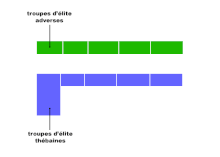Inclined order of battle
The crooked order of battle is one of the 4th century BC. Chr. Developed military tactics of combat, in which one wing of the army is massively reinforced at the expense of the other. The tactic has the goal of achieving a point superiority over a numerically stronger opponent in order to force a decision. One of its last uses in the classical form was on December 5, 1757 by Prussian troops in the battle of Leuthen .
In the leaning order of battle, a clash of the opponents on a broad front is avoided. The reinforced wing is pushed forward, while the other, weakened, only fights slowly and delays or avoids contact with the enemy. By massaging on one side, the break-in into the opposing front is forced in the event of success and this is then rolled up by pivoting inwards from the flank. The opponent can no longer compensate for this tactical advantage even through numerical superiority, especially when the tactical units such as B. the Greek phalanx are relatively immobile and therefore prone to flanking. It is crucial for success that the opponent only notices this intention when it is too late for regrouping, otherwise he simply reinforces the threatened wing or even turns the tables and attacks the weak wing that is hanging back. As the opportunities for battlefield reconnaissance became better and better from the late 18th century, the tactic fell into disuse.
history
The earliest documented application of the Leaning Order of Battle occurred by the Theban general Epaminondas at the Battle of Leuctra in 371 BC. In the conflict between Sparta and Thebes . Of 700 Spartians, 400 died, including King Cleombrotus I.
The phalanx tactic was very costly, especially for the losers, and usually brought about a decision early on. Traditionally, the best units were placed on their own right wing, which then hit the worst quality units of the opponent on their left wing. Often this resulted in a success of the own right wing and a defeat of the left wing and a subsequent decision in the center after the two right wings swung in. This was reinforced by the effect that during the advance of the phalanx its mass shifted from left to right, thus the right wing became denser and heavier and achieved greater attack force. Historians such as Peter Connolly attribute this to a very human characteristic: the hoplite wore his shield on his left arm, thus covering his left half of the body and the right shoulder of his left neighbor with his own shield, as well as his own right shoulder through the hoplon of his right Neighbor was protected. When moving, there would now be a natural tendency to move to the right into the protection of the neighboring shield. The right wing of the phalanx thus had a “natural” superiority, which was reinforced by the Greeks by positioning the best units on this “honorable” wing (which usually won the battle).
At Leuktra , the Thebans turned this effect around by staggering their left wing deeper and closer and manning them with elite units, as well as allowing the left wing to march further forward. The surprisingly strong left wing of the Thebans met (before the collision of the rest of the phalanx) on the right wing of the Spartans and literally overran it. After this defeat of the elite right wing (where the Spartan king had stood) the weaker remainder of the Spartan order of battle quickly collapsed.
The crooked order of battle was later adopted by Alexander the Great and perfected by means of the Macedonian phalanx and above all a superior cavalry. Hannibal repeatedly used a modified form of this tactic . With the use of the leaning order of battle, Caesar succeeded in winning the battle of Pharsalus over a republican army that was far superior in numbers; he ended the civil war against Pompey .
Even Frederick the Great won the 5. December 1757 , the Battle of Leuthen by a feint and a skewness of battle by 20 on his right wing battalions at a distance of 50 meters in total about 1,000 meters set back positioned and after the successful flank attack the enemy army side rolled up.
See also
- Holy crowd
- Pezhetairoi (companions on foot)
literature
- Victor Hanson: Epameinondas, the Battle of Leuktra (371 BC) and the "Revolution" in Greek Battle Tactics . In: E. Wheeler (ed.), The Armies of Classical Greece . Aldershot 2007, pp. 503-520.
- Johannes Wolter: The Battle of Leuktra 371 BC Chr. Leipzig 1925.
- Detlef Lotze: Greek History - From the Beginnings to Hellenism. Munich 2007.
